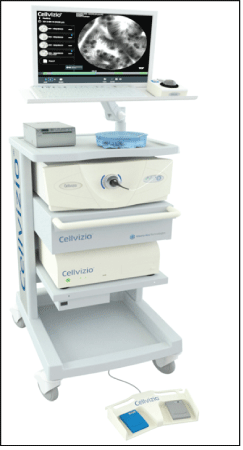
Figure 1: Cellvizio®, Mauna Kea Technologies (France).

Dolidze DD1,2 Mel’nik KV1* Gazzaev DV3
1Russian Medical Academy of Continuous Professional Education (RMACPE), Moscow, Russia*Corresponding author: Mel’nik KV, Russian Medical Academy of Continuous Professional Education (RMACPE), Moscow, Russia, E-mail: jimrack@mail.ru
In this study were the results of application of the first real-time laser confocal microscopy in intraoperative study at various thyroid diseases. The study was conducted in 34 patients aged from 24 to 55 years. Among them were 20 (58.8%) patients with nontoxic multinodular goiter, 8 (23.5%) with thyroid adenoma and 6 (17.6%) patients with thyroid carcinoma.
Thyroid gland; Real-time confocal laser microscopy
Currently, the morphological diagnosis of Thyroid Disease (TD) consists of several stages: preoperative-fine needle aspiration biopsy (TAB), intraoperative-urgent cytological and frozen sections examination, postoperative-planned histological examination. The results of TAB before surgery and urgent investigations during surgical analysis [1-3] have the greatest significance for determining the tactics of treatment and the volume of surgical intervention. However, according to a number of studies, the information obtained from urgent investigations is controversial and does not allow for a reliable differential diagnosis of benign and malignant thyroid neoplasms [4,5]. In this regard, it is interesting to search for new ways to improve the intraoperative examination of patients with various thyroid diseases. Currently, Confocal Laser Microscopy (CLM) in real time, which was invented by Minsky M, et al. [6], is already used for the diagnosis of the gastrointestinal tract, bronchopulmonary system and skin diseases [7,8]. This technique allows you to make an accurate morphological diagnosis directly during the CLM procedure with tissue inspection, which determines advantages over other imaging diagnostic technologies and is of undoubted interest for clinical use. The experience of using this method for the study of thyroid tumors has not previously been recorded.
To determine the role of CLM with in vivo real-time examination of tissues for the intraoperative diagnosis of thyroid diseases.
The data presented in the analysis of the results of the study of 34 patients who were in the Botkin State Clinical Hospital in the department of endocrine surgery.
According to the nosological forms, the patients were distributed as follows: Multinodular Nontoxic Goiter (МG)-20 (58.8%), Thyroid Adenoma (TA)-8 (23.5%), papillary carcinoma-6 (17.6%). The average age of the observed patients was 48 years. The ratio of men and women is 1:6. All patients in whom it was planned to perform hemithyroidectomy intraoperatively conducted an urgent histological study. Along with this study, real-time CLM was used, which is based on the principle of confocal fluorescence microscopy [9].
Initially, we clarified the morphological features of the structure of the thyroid gland and its changes during pathological processes. The main structural components of the parenchyma of the gland are follicles-closed spherical formations with a cavity inside, with a diameter of 20-200 microns. The wall of follicles with a thickness of up to 0.2 microns is formed by a single layer of epithelial cells-follicular thyrocytes. The follicles are separated by thin layers of loose fibrous connective tissue with numerous blood and lymphatic capillaries intertwining the follicles, as well as mast cells and lymphocytes. In tumor processes, its stroma provides the tumor itself with structural organization, blood vessels and interstitial connective tissue, differing from normal [10-12]. In the stroma of the tumor, the already existing vessels of the basal membranes and the formation of new capillary networks are actively degraded [13]. The synthesis of fibrin in the tumor is increased [14,15], as a result of which massive sclerosis occurs [16,17]. The basis of the connective tissue of the interstitial tumor stroma consists of interstitial collagens (mainly type I and III), fibrin, fibronectin, elastin and laminin and glycosaminoglycans [18].
Compared with benign tumors, in malignant processes, sclerosis is more pronounced, as well as structural disorganization, on the basis of which differential diagnosis is made between benign and malignant tumors.
We tried to fix these features using an intravital CLM, in which a 488 nm laser generates a beam and transmits it using mirror systems. At the exit from the workstation, the laser beam passes through a multi-fiber fiber-optic probe and hits the surface of the tissue being examined. A part of the light is absorbed, and another part induces tissue fluorescence, which is recorded by a confocal microscope and processed by a computer, allowing a dynamic monochrome image to be obtained on a monitor [19]. Thus, with CLM, it is possible to achieve the visualization of those structures that have an autofluorescence effect. The main endogenous fluorophores of biological tissues include flavins, proteins and porphyrins. Each fluorophore has specific absorption and emission spectra [20,21]. When using monochromatic light with a wavelength of 488 nm, the luminescence of biological substances rich in NADH, lipopigments, and also collagen and elastin occurs [22]. The last ones are part of the basal membrane of the follicles and numerous vessels of the microcirculatory bed, located in the connective tissue capsule. Layers of the latter are sent inwards and divide the body into lobes. With CLM it is possible to register images of the connective tissue component of the thyroid tissue and its bulk formations. Based on this, a study of thyroid tissue was conducted.
The CLM procedure was carried out using a Cellvizio® instrument manufactured by Mauna Kea Technologies (France) (Figure 1).

Figure 1: Cellvizio®, Mauna Kea Technologies (France).
Special probes do not yet exist for the study of the thyroid gland, therefore the broaches “Demo” and “Gastoflex” were used for its study, the resolution of which reaches 50 and 20 µm, respectively, with the possibility of increasing from 400 to 1000 times, which is comparable with the size of the thyroid follicles. Depth of research 0 to 60 microns, field of view from 240 to 600 μm. Before carrying out the CLM, Cellvizio® was adjusted in accordance with the prescription and the broach was calibrated. There is no experience of using KLM for studying the thyroid gland, so the primary task for us was to develop methods for obtaining, describing and analyzing confocal microscopic images of thyroid tissue. For this, after surgery, the specimen was examined together with pathologists. Next, sections of the macroscopically unchanged thyroid gland and the slice of mass formations were made, which were examined with a Cellvizio confocal laser microscope (Figure 2).
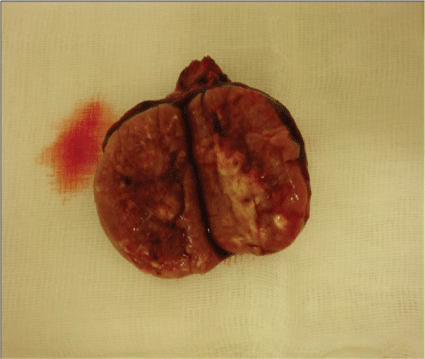
Figure 2: Patient L., 63 years old, cut of thyroid lobe with papillary carcinoma.
For this, the optical mini-broach was brought to the slice and held in the area of interest for the entire time needed for the study (2 min ± 1 min). Each area was scanned several times (minimum 3) to obtain a stable, clear confocal image. Video recordings and images with signs of artifacts were not taken into account and were excluded from the study. Then, micro preparations were prepared from sections delayed studied with the help of CLM, which were examined and photographed by pathomorfologists.
On the basis of the conducted research, the signs that are characteristic of unchanged thyroid tissue, adenoma and thyroid carcinoma were identified.
When studying the normal thyroid tissue, an image resembling a mesh with cells of the same size, round or polygonal in shape, 20-200 µm in diameter with a 0.2 µm septum thickness was recorded, which corresponded to the size of a normal follicle and the thickness of the basal membrane. When nodular colloid goiter was also recorded mesh image, however, the diameter of the cells was more than 200 microns and could exceed 1000 microns (Figure 3).
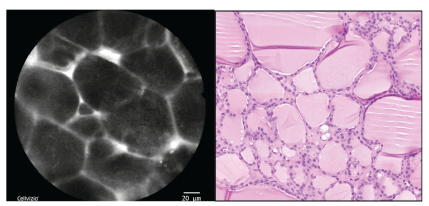
Figure 3: Patient K., 45 years old, with nodular colloidal proliferating goiter. Images obtained with real-time CLM and a standard light microscope for routine histological examination.
TA in some areas, an image resembling an image with cells with a diameter of 20-200 µm, usually 30-60 µm, was recorded, but the thickness of the partitions was 10-30 µm. At the same time there were areas of fibrosis of various thickness and length (Figure 4).
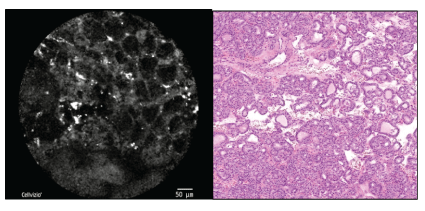
Figure 4: Patient S., 56 years old, with microfollicular TA. Images obtained with real-time CLM and a standard light microscope at routine histological examination.
During cancer of the reticular pattern was not observed, almost the entire field of view was replaced by coarse structure less fibrous tissue, where periodically there were patches of irregular shape of different sizes, sometimes merging, arranged in a chaotic manner (Figure 5).
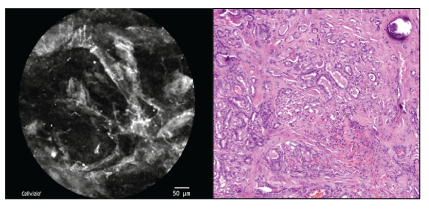
Figure 5: Patient L., 63 years old, with papillary carcinoma of the thyroid gland. Microscopic photographs taken with real-time CLM and a standard light microscope for routine histological examination.
Outside of the tumor, the macroscopically unchanged thyroid tissue in the probe examination most often had a characteristic picture of the thyroid.
Intra-operative study of the thyroid with the help of CLM allows differentiating in real time the space-occupying formations of the specified localization. However, today it is still too early to talk about the possibility of the clinical application of this technology, which is due to the lack of specificity of the detected changes and the difficulty in interpreting the data obtained. The lack of standards for the qualitative and quantitative evaluation of the visual images of the thyroid gland in the CLM process requires serious research based on the analysis of a large amount of material of patients of the specified categories. Thus, CLM is a modern way to study tissues in real time, and with further improvement it can be of great importance in pre- and intraoperative examination of patients with various thyroid diseases with the definition of treatment tactics.
Download Provisional PDF Here
Article Type: RESEARCH ARTICLE
Citation: Dolidze DD, Mel’nik KV, Gazzaev DV (2019) Real-Time Confocal Laser Microscopy for Diagnostics of Thyroid Diseases (First Experience). J Surg Open Access 5(6): dx.doi.org/10.16966/2470-0991.194
Copyright: © 2019 Dolidze DD, et al. This is an open-access article distributed under the terms of the Creative Commons Attribution License, which permits unrestricted use, distribution, and reproduction in any medium, provided the original author and source are credited.
Publication history:
All Sci Forschen Journals are Open Access